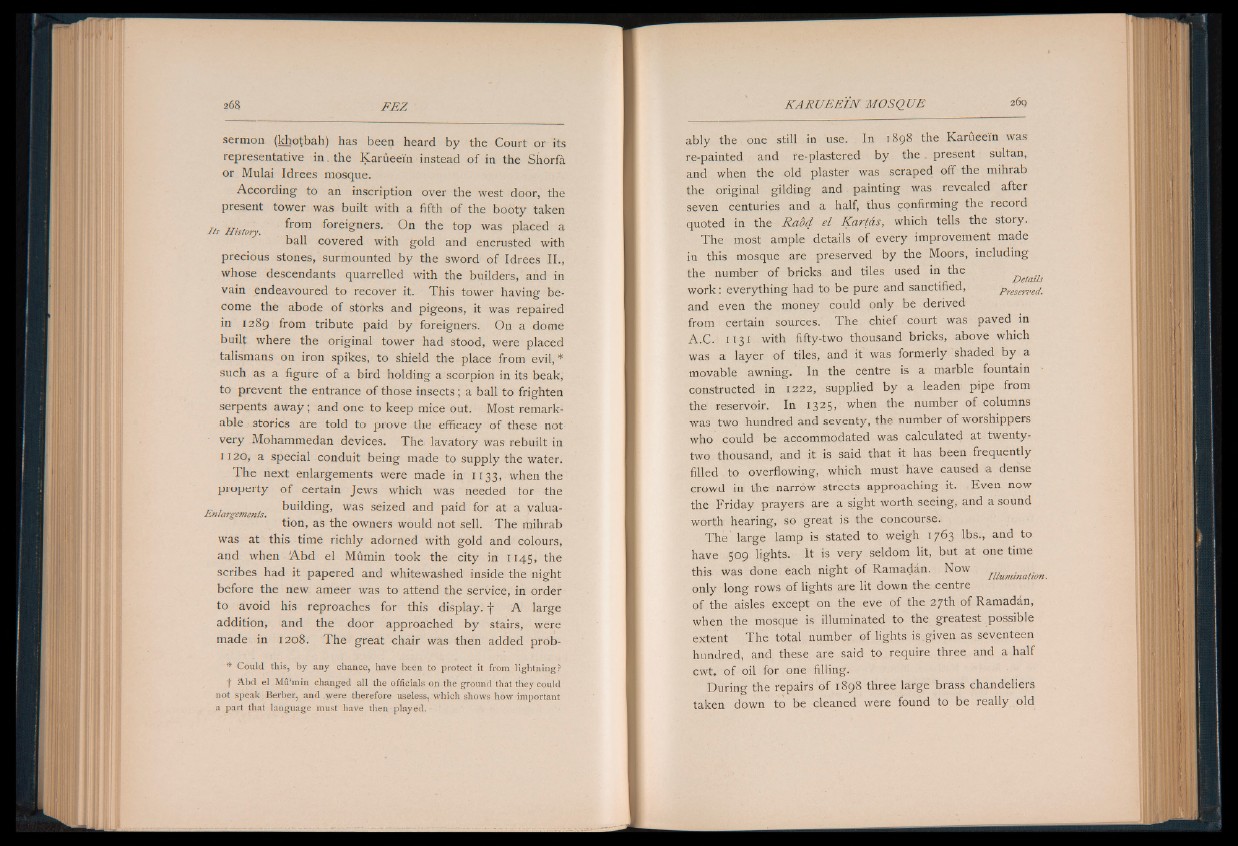
sermon (khotbah) has been heard by the Court or its
representative in. the Karueei'n instead of in the Shorfa
or Mulai Idrees mosque.
According to an inscription over the west door, the
present tower was built with a fifth of the booty taken
Its Histoi fr°m foreigners. On the top was placed a
ball covered with gold and encrusted with
precious stones, surmounted by the sword o f Idrees II.,
whose descendants quarrelled with the builders, and in
vain endeavoured to recover it. This tower having become
the abode of storks and pigeons, it was repaired
in 1289 from tribute paid by foreigners. On a dome
built where the original tower had stood, were placed
talismans on iron spikes, to shield the place from evil,*
such as a figure of a bird holding a scorpion in its beak,
to prevent the entrance o f those insects; a ball to frighten
serpents aw a y ; and one to keep mice out. Most remarkable
stories are told to prove the efficacy of these not
very Mohammedan devices. The lavatory was rebuilt in
1120, a special conduit being made to supply the water.
The next enlargements were made in 1133, when the
property o f certain Jews which was needed for the
„ , . building, was seized and paid for at a valua- Enlargements»
tion, as the owners would not sell. The mihrab
was at this time richly adorned with gold and colours,
and when A b d el Mumin took the city in 1145, the
scribes had it papered and whitewashed inside the night
before the new ameer was to attend the service, in order
to avoid his reproaches for this display, f A large
addition, and the door approached by stairs, were
made in 1208. The great chair was then added prob*
Could this, by any chance, have been to protect it from lightning?
t Abd el Mu’min changed all the officials on the ground that they could
not speak Berber, and .yvere therefore useless, which shows how important
a part that language must have then played.
ably the one still in use. In 1898 the Karfieein was
re-painted and re-plastered by the . present sultan,
and when the old plaster was scraped off the mihrab
the original gilding and painting was revealed after
seven centuries and a half, thus confirming the record
quoted in the Raòd el Kartàs, which tells the story.
The most ample details of every improvement made
in this mosque are preserved by the Moors, including
the number of bricks and tiles used in the
• r j Details
work : everything had to be pure and sanctified, Preserved.
and even the money could only be derived
from certain sources. The chief court was paved in
A.C. 1131 with fifty-two thousand bricks, above which
was a layer of tiles, and it was formerly shaded by a
movable awning. In the centre is a marble fountain
constructed in 1222, supplied by a leaden pipe from
the reservoir. In 1325, when the number of columns
was two hundred and seventy, the number of worshippers
who could be accommodated was calculated at twenty-
two thousand, and it is said that it has been frequently
filled to overflowing, which must have caused a dense
crowd in the narrow streets approaching it. Even now
the Friday prayers are a sight worth seeing, and a sound
worth hearing, so great is the concourse.
The' large lamp is stated to weigh 1763 lbs., and to
have 509 lights. It is very seldom lit, but at one time
this was done each night of Ramadan. Now Illuminalion
only long rows of lights are lit down the centre
of the aisles except on the eve of the 27th of Ramadan,
when the mosque is illuminated to the greatest possible
extent The total number of lights is given as seventeen
hundred, and these are said to require three and a half
cwt, of oil for one filling.
During the repairs of 1898 three large brass chandeliers
taken down to be cleaned were found to be really old